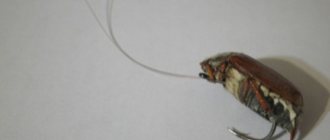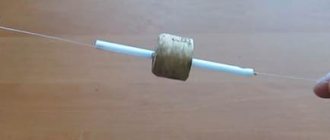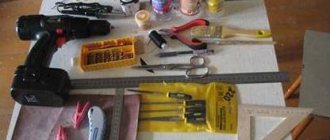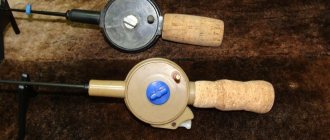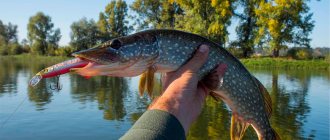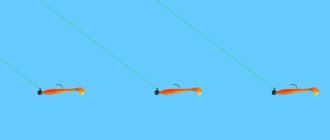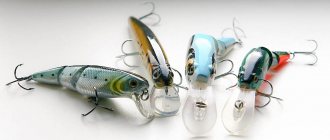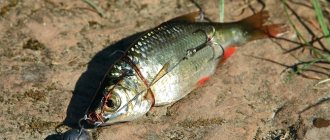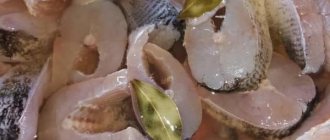"Mouse" with your own hands.
Recently, when writing one of the articles, I mentioned the “mouse” bait. This bait has been used since time immemorial, and has always been considered catchy. Preparing for an autumn pike trip, I’m picking up a gentleman’s set of tackle and I wanted to add this bait to my arsenal.
The shopping trip was disappointing - I didn’t have what I wanted. So I decided to make a “mouse” myself, and at the same time share my manufacturing experience with you.
What we need:
First of all, the material to create the body of the mouse. Most people make mice from wood, but I prefer cork - less problems with getting wet. To make 2 mice you need 1 cork.
To make a skin you need fur. Any. I tore up old winter boots for all the consumables (leather and fur) - they come in handy from time to time  .
.
Additionally - a large paperclip, a large double (not for an elephant, but still), 1-2 beads, a flat piece of lead (you can flatten the sinker with a hammer)
Cut the cork lengthwise into two parts.
Lay down half of the cork and cut out a conical groove for inserting a metal base and weight
We cut off a narrow edge from the cut out part so that when inserting the cut out part into place, a cavity is formed.
Now we create a “filling” from a large paper clip and a double. I immediately attached the swivel so as not to have to deal with it later.
In order for the bait to take the correct position in the water and fly further (a cork covered with fur + a tail - God forbid!), we need to load our mouse. To do this, cut out a strip of lead and bend it.
Don't overload! Otherwise, your mouse will float like an ax and you won’t be able to move it correctly. A load of around 5 grams is quite enough, and sometimes even a lot 
Now we crimp the lead strip onto the metal base
That's it, the base can be glued. You will end up with something like this:
In principle, you can already catch with this 
I want to have something more solid, and therefore I will continue to do so. In order to add attractiveness to the bait, it is worth supplementing it with something that creates vibrations that the pike perceives from a much greater distance than its appearance.
I add a spinner like a rocket bait. The pinwheel is a circle made of tin with blades cut on it. I use 1-2 beads as a bearing. The spinner should begin to rotate at the slightest breath.
Instead of a spinner, you can plant a petal from a rotating spoon, or a tail or two from a twister. Here's who will like what.
We clamp a thin strip of leather on the remaining end of the paperclip, simulating a tail, and our “mouse” is ready to be covered with fur.
After pasting it with fur, we finalize our bait - trim the fur (the shorter it is, the less water it collects). You can glue in an imitation of the rear (rowing) legs from the tails of defective twisters, for example these:
Our “mouse” is ready! It's time for the pike!
What's good about this bait? The fact that it can be guided through the most overgrown “toad grass”. The tips of the hooks pointing upward do not cling to anything.
You need to move the bait slowly, imitating a swimming mouse. Pause when the “mouse” overcomes a water lily leaf, twig, etc. - “the mouse is resting”  ))))).
))))).
In addition to pike, catfish and taimen are very fond of the mouse. The only thing is don’t use this bait in the middle of large water areas - mice crossing the seas only happen in fairy tales.
Enjoy fishing! No tail, no scales!
Yaroslav Shkryl.
Share news:
Mouse from a wine cork on a trophy pike
Greetings fishermen, in this instruction we will look at a method for making a very unique tackle - a homemade mouse. These small animals are very popular food for many predators and others. Mice are readily attacked by pike, and often trophy specimens are caught from such hunters. Large chub, asp and other fairly large predators also prey on mice.
Of course, we won’t catch a live mouse; we don’t need one, because we can make as many mice as we like with our own hands, which we won’t need to feed. As a material for production, you can use wine corks, which have a narrow and wide part. Using them, it is very easy to shape the shape of the mouse's body, which is narrow in the front and wide in the back. Everything is done quite simply, few tools are needed, and the tackle we get is interesting and catchy. Using the same principle, you can make frogs, which are also actively attacked by fish. Basically, you can just paint the bait green, it looks just as good as a frog as it does a mouse. So, let's start manufacturing.
Materials and tools used by the author: List of materials:
- wine stopper; - stainless steel wire; — two tees and rings; - lead for loading; - Super glue; - lace (for the ponytail); - paint, varnish (or nail polish).
List of tools:
- stationery knife; - sandpaper; - round nose pliers; - wire cutters; - scissors.
Homemade manufacturing process:
Step one. Cutting out the main profile
First of all, let's cut out the main profile of the bait; it is important for us to imitate the shape of the mouse's body. If you have ever seen a mouse, you have probably noticed that its front part is narrow, and its back part is wider due to its paws. Of course, there are different breeds of mice, and ordinary terrestrial mice often cannot swim. Therefore, it is advisable for us to repeat the shape of a water mouse. Our cork already has a similar shape, we just need to finish it. We arm ourselves with a stationery knife and simply cut off the excess. We work with the knife carefully, as the material is quite strong and the knife is very sharp!
Don’t forget to also cut out something like ears on the bait; however, it’s unlikely that a predator will look at it. Make the mouse's belly a little flat.
Step two. Grinding
When we cut out the profile, we begin grinding, this procedure is necessary in order to grind off rough edges and so on. Coarse sandpaper will do. It is convenient to work on a small sharpener if you have one. Actually, that’s all, we should finish with the tackle profile in these steps. All that remains is to install the hooks and loops and paint the mouse.
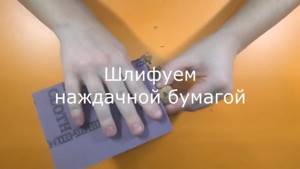
Step three.
Installing the frame The frame is a kind of skeleton to which the hooks are attached, and the main fishing line is also tied. The hooks here are located in the back on the sides; they imitate paws. In addition, the location of the hooks is quite good for a good fish hook. The skeleton has the shape of the letter “T”, we make it from steel, preferably stainless wire. However, you can also use copper wire, but keep in mind that it is not so strong. The skeleton is solid, first we form a loop to which the fishing line is tied, and then one of the side loops for the hook, and then we make a third loop in the same way.
Step four. Load and tail
The tail is a very important part of the bait, since it is thanks to it that the bait appears like a mouse when viewed from the depths. To make a ponytail, cut the lace to a suitable length. Make a slit in the back for the tail and push the end there.
Now we need to secure the whole thing; for these purposes the author uses superglue. We thoroughly fill all our slots with it. And in order for everything to hold better, we cut off and install in the cracks the very pieces that were cut out from here. At the end, fill everything with glue and compress it for a while.
Step five. Painting
You can start painting. The belly of mice is often light and the back is dark. The author used nail polish for coloring. In principle, the cork cannot absorb water, but it is best to completely dip the bait in varnish after painting. Be sure to draw the eyes of the bait; this is one of the main identifiers by which a predator recognizes its prey, as many fishermen believe.
Before painting, it is recommended to wrap the mouse's tail with masking tape to prevent accidental painting, but this is unlikely when working with a brush.
Step six. Installation of hooks
Our mouse is ready! Now we install the hooks. Doubles are suitable here, or better yet tees for a more likely hook. You can use winding rings to attach the hooks; they are easy to use and reliable. But the author took ordinary rings and bent them with pliers. This is not very reliable, since the hook can come off under heavy load. That's all, the tackle is ready, you can test it!
That's all, good fishing, don't forget to share your impressions and results if you decide to repeat this bait! I hope you liked the project and found something new for yourself. Good luck and creative inspiration in making!
Source
Become the author of the site, publish your own articles, descriptions of homemade products and pay for the text. Read more here.
What baits are best to use?
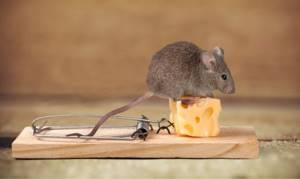
To catch a rodent, it is enough to use some, not tricky, simple but effective devices. The main task is to lure this creature. To do this, you need to know what mice love most, despite the fact that they are practically omnivores. Sometimes mice eat things that are not considered edible. For example, they chew the insulation from wires and eat foam. There are also myths that concern which bait is most attractive to mice. It is believed that mice love cheese most of all.
The most acceptable baits
The bait must have a strong, pleasant odor, otherwise the mice will ignore it. At the same time, the product should not contain chemical components that can repel mice. In addition, the product must be fresh. No rotten or semi-spoiled foods, such as fish, meat, sausage, seeds, or cereals, are in any way suitable as bait.
Prevalence and lifestyle
Taimen has an elongated body of a silvery color, which acquires a dark red hue during the spawning period. Along the entire body there are many black spots, mostly round in shape. The head of taimen resembles the structure of a pike; the upper and lower jaws are also compressed. A wide mouth filled with two rows of sharp teeth allows it to hunt large prey.
Taimen is a maneuverable fish that develops extremely high speed in the water column. He is helped in this by his long, compressed body, and, of course, powerful fins. Sexual maturity occurs at the age of 7, when the fish gains up to 4 kilograms of weight. Prolonged maturation is one of the reasons for the numerical decline of the population, although humans are still considered the main culprit for this. Poaching and unlimited fishing, fishing during the spawning season, dumping waste into rivers - all this has a detrimental effect on representatives of the ichthyofauna.
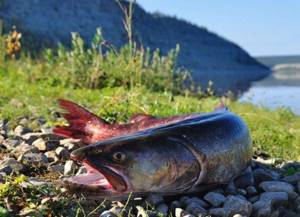
Some interesting facts about taimen:
- The predator is considered a sedentary species, since throughout the entire period of its life it does not leave the original body of water. Moreover, taimen does not like to change the section of the river and does this only in extreme conditions.
- In the last century, fishermen came across specimens up to 3 meters in size. Today, unfortunately, such giants cannot be found.
- Like the entire salmon family, taimen loves clean, oxygenated water. In the warm season, the predator occupies shaded areas of rivers, where the water warms up more slowly. During the winter, taimen can enter deep lakes or remain in river holes.
- You can identify taimen by looking at their boilers. Especially often, the fish allows itself to be discovered in the morning, when the handsome spotted fish goes out into the shallow riffles in search of food. Strong splashes heard on a quiet morning attract the attention of anglers.
Read: Fishing in the Urals
The predator's food supply includes animal food: small fish, insects that have fallen into the water, as well as rodents. One of the most effective baits is considered to be an artificial mouse, which taimen rarely let pass by.

Bottle trap: 4 types
There are several other ways to catch a harmful animal.
Trap from a plastic bottle

How to make:
- Cut off the bottom of a container with a capacity of one and a half liters. Cut the edge into triangles with scissors (length 6-8 cm).
- Place bait with a pungent odor (cheese, lard) inside.
- Carefully bend the triangles with their sharp ends inside the trap.
- Lay the structure sideways on a horizontal surface. The mouse will sneak behind the bait, but the curved teeth will not allow it to get out of the trap.
Glass bottle mousetrap
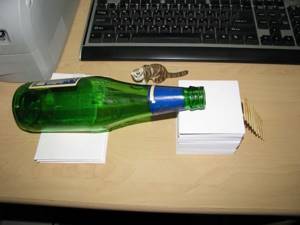
Manufacturing:
- Take a 0.7 liter glass container with a wide opening, a champagne bottle is ideal.
- Pour a tablespoon of warm oil inside. Oil should be chosen with a strong aroma (unrefined sunflower, olive).
- Shake the structure to coat it from the inside, coat the neck.
- Set the trap obliquely on the floor with the neck up. The mouse will climb inside, but will not be able to get out due to the slippery surface.
Trap from a cut bottle
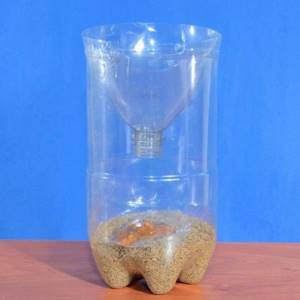
Anyone can make such a trap.
Step-by-step instruction:
- Carefully cut the two-liter bottle in half with a sharp knife. The bottom part should be larger than the neck part.
- Place a piece of food at the bottom of the first part, tightly insert the second part with the neck inward.
- Secure the edges of the device with tape, wire, or a stapler. Grease the top with oil. The rodent will get into the neck, but will not be able to crawl back out.
Trap from a bottle and bucket
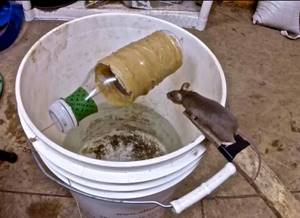
A basin, a small bucket and a bottle with a capacity of 0.5 liters, can also be used as a mousetrap.
To build a trap, you need to prepare:
- small bucket, basin;
- soda bottle;
- stick or thick iron rod;
- a strip of thick cardboard;
- bait
How to do:
- Pour water into the bucket (a little less than half). Prepare a stick or rod by measuring a length greater than the diameter of the bucket.
- Pierce the bottom of the bottle and insert a stick.
- Attach a delicious-smelling treat to the side of the bottle with tape (bread dipped in vegetable oil is ideal).
- Place the stick on the edge of the bucket.
- Cut a strip out of cardboard and make a “bridge” along which the mouse can get to the bait. Having climbed onto the bottle, the animal will turn the structure and end up in the water.
Features of catching taimen with a mouse
You should go fishing at night. Experienced Russian fishermen know that fish even during the day pick up mice and squirrels that fall into the water. Excellent vision allows taimen to instantly react and attack the bait. However, it is not so easy to deceive an avid representative of wild rivers and reservoirs.
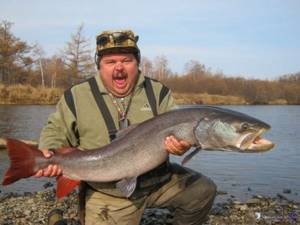
As night falls, it becomes much easier to catch the coveted specimen. In complete darkness, taimen begins to search for food and carefully detects the slightest fluctuations in the water with its lateral line. He waits for the moment when the mouse hits the water, creates a splash and begins to swim. This is an excuse to feast on the fearless victim.
Sometimes cones are found in taimen. This suggests that the fish is able to react to any splash and indiscriminately swallow the food it comes across. The fisherman can only choose a suitable bait and wait for a bite.
For fishing, use a jig spinning rod with a dough from 10 to 50 grams, 3 meters long; a spinning reel and fishing line of your choice: braided or fluorocarbon.
Read: Catching Sakhalin taimen
Important Rules
Fishing at night should be done carefully and quietly so as not to spook the taimen. Excessive talking, whispering, flashlights, coughing and other fuss will negatively affect the bites. Only in case of hooking, you can highlight a little for convenience.
Taimen will not immediately take the bait. First he will start to suppress it with his tail. You will know this by the popping sounds in the water. After the first jerk occurs, do not hook or wind the line. When the cord is tight, then hook and start fishing.
Catching taimen with a mouse, as you can see, requires some preparation. Follow all the rules and luck will be on your side.
